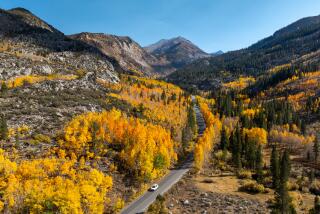Showing Their Hidden Colors
- Share via
There’s a reason some leaves change colors in the fall, and, despite what the fairy tales say, it doesn’t have anything to do with wood sprites.
Leaves contain millions of chloroplasts. In the summer, chlorophyll, the pigment that makes leaves green, is dominant. As a tree goes dormant in the fall, the chlorophyll breaks down and the pigments xanthophyll and carotene can be seen in leaves more clearly, turning them shades of yellow and orange.
Deciduous trees on the West Coast play by a different set of rules than their eastern cousins, said Mike Evans, co-owner of Tree of Life Nursery in San Juan Capistrano.
“In the Northeast, the temperatures get lower quicker, and the trees truly go dormant,” Evans said. “Our area in Southern California is almost subtropical, and many of the native trees here are not as dependent on cold temperatures” for their leaves to change colors.
But if you think the local fall foliage arrived a bit more dramatically this year than in the past, it’s not entirely your imagination.
“The few hours of cold we get are enough to trigger some species into dormancy,” Evans said.






